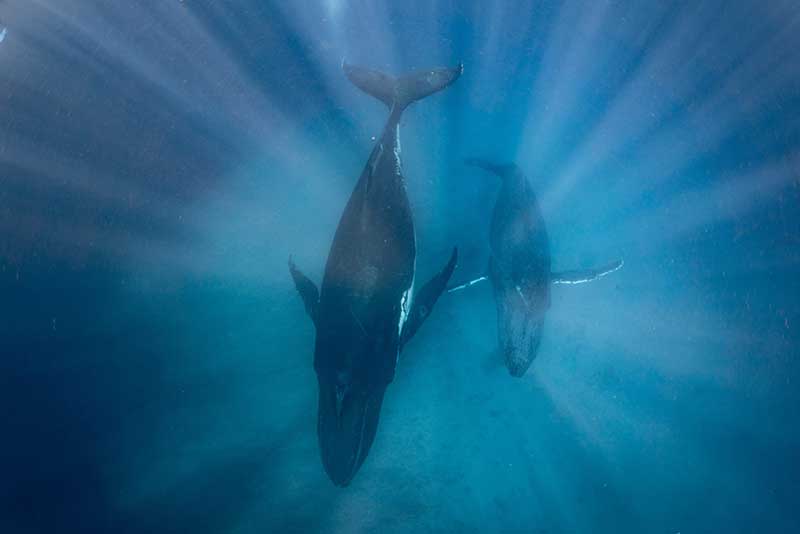Want to know some ‘whaley’ awesome facts about humpback whales?
The annual humpback whale migration along the west coast of Australia is said to be one of the largest in the world, estimated to see around 40,000 humpback whales migrating along the coast every year.
With our large population of visiting humpback whales and our already established ecotourism operations, this makes Ningaloo one of the best places in the world for whale watching and attempting an in-water interaction with one!
Ningaloo Whale shark Swim’s humpback whale interaction tours are designed to provide amazing opportunities to interact with these majestic mammals, but also to experience the amazing wildlife of the World Heritage listed Ningaloo Reef.
Quick Humpback Whale Facts
- Australia has two distinct populations on the East and West coast that do not mix
- They can weigh up to 45,000kg and grow to 16m in length
- They live 60-80 years and mature around 12 years old
- Humpbacks are baleen whales, feeding on over 1 ton of krill per day
- Females will calve once every 2-3 years

Humpback Whale History
Humpback whales were historically hunted as they provided valuable meat and oil products. They were one of the preferred species targeted by the commercial whaling industry. The Ningaloo even had its own whaling station at Norwegian Bay, just two hours drive south of Exmouth.
A Norwegian whaling company established the whaling station, which began in 1912 as steam powered ships with harpoon guns and factory ships. A 160m long jetty and land-based facility was later built, including oil tanks, boilers, processing plants, slipways and workers quarters. Between 1913 and 1916, they killed more than 4,000 whales. Over the years, the station went through closures and change of hands until its closure in 1957.
You can still see the remnants of this whaling station at Norwegian Bay. Various materials are scattered along the beach and seabed, including bottles, fuel drums, cables, wiring and piping.
Globally, whaling continued. At the peak of the whaling industry in the 1960/70’s, global Humpback Whale numbers were reduced by more than 95%, nearing extinction levels.
Realising this decline, the humpback whales have been protected in the southern hemisphere since 1963. Years later, in the 1980’s, the International Whaling Commission put in place a temporary ban on commercial whaling due to the overexploitation of global whale stocks. This is known as the commercial whaling moratorium and it remains in place today. This ban has effectively created the most successful conservation story in the animal kingdom, with humpback whale numbers coming back from the brink of extinction to pre-whaling numbers.
Humpback Whale Biology
The humpback whale, Megaptera novaeangliae is named after their large pectoral fins (‘Mega’ = large, ‘ptera’ = wings). They have a very distinct bulky body shape and a thin head. They can be identified by bumps or tubercles on the head and front edge of the fins.
Humpback whales live in all oceans of the world, however, there are very distinct populations around the world. Our populations in Australia are different on the East and West coast. A whale that you see on tour with us, you will never see on the east coast.
Our humpback whales usually only feed during the summer months in Antarctica when the krill is plentiful. Humpback whales are filter feeders, eating small things like krill, small fish and plankton. They can consume more than 1 ton of krill per day. They will live off their reserves for the remainder of the year during their migration to the northern warmer waters.
Whale song
Whales are vocal creatures, with humpback whales being no exception. Hearing a whale song underwater is hauntingly beautiful and can often be heard during our outer reef activities. There are two distinct types of whale vocalisations: songs and calls.
While all humpback whales can vocalise, it is believed only the males will sing. Songs usually consist of repetitive sounds in a sequence. The humpback whalewhales song can be highly complicated and new sounds are added on each year until it becomes too complicated and they will start again. What’s truly fascinating is that humpback whale songs are similar in the same population but vary from different populations in different oceans. The other vocalisations, calls, are non-repetitive short sounds, usually clicks, moans and grunts. Some of these low frequency sounds can travel more than 10,000 miles.
The purpose of the whale song is still uncertain, but as it is mostly heard in breeding areas, it may have to do with attracting a mate or even challenging other male humpback whales in the vicinity.
Humpback Whale Acrobatics
Humpback whales are the most surface-active whales and often display many acrobatics for whale watchers to enjoy.
Breaching
This is a stunning display of strength and agility. It involves a whale propelling itself upwards out of the water, leaping mostly or completely out of the water, followed by a big splash back into the water on its side. It is the humpback whale’s signature move and a truly spectacular surface display to witness.
Spy-hopping
When a whale gets curious and wants to have a look at what is happening above the surface. It’s less effort than a full body breach, more simply involves the whale floating their body upwards and pushing their head above the water so they can see. Humpback whales have a special cornea that allows them to see just as well above water as they do below.
Tail Slapping
This behaviour sees the whale lifting its massive tail out of the water and slapping it down, creating a big splash and a loud slapping sound. That is why this behaviour is believed to be used for communication.
Pectoral Slapping
This involves the humpback whale rotating on its side and repeatedly swinging its pectoral fins side to side out of the water, creating a similar slapping sound to the tail slap. Sometimes they will lay on their back and slap both pectorals out to either side.






